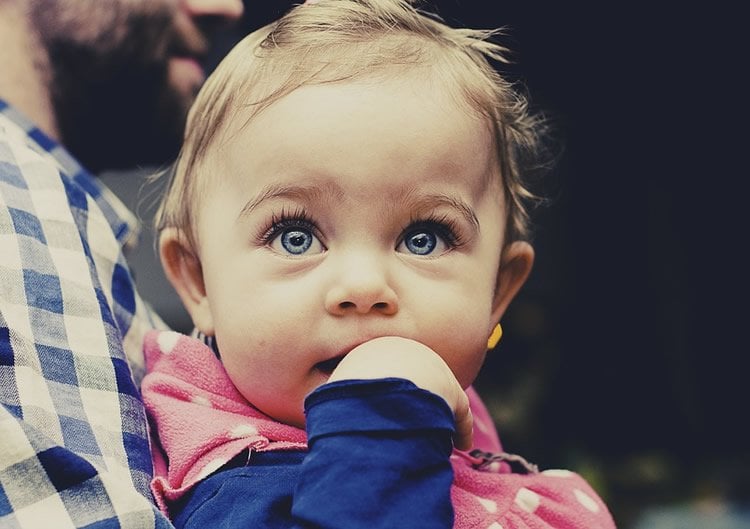Summary: Researchers report infants show racial bias in favor of members of their own race as early as 6 months old.
Source: University of Toronto.
Racial bias begins earlier than previously thought, new insights into cause.
Two studies by researchers at the Ontario Institute for Studies in Education (OISE) at the University of Toronto and their collaborators from the US, UK, France and China, show that six- to nine-month-old infants demonstrate racial bias in favour of members of their own race and racial bias against those of other races.
In the first study, “Older but not younger infants associate own-race faces with happy music and other-race faces with sad music”, published in Developmental Science, results showed that after six months of age, infants begin to associate own-race faces with happy music and other-race faces with sad music.
In the second study, “Infants rely more on gaze cues from own-race than other-race adults for learning under uncertainty”, published in Child Development, researchers found that six-to eight-month-old infants were more inclined to learn information from an adult of his or her own race than from an adult of a different race.
(In both studies, infants less than six months of age were not found to show such biases).
Racial bias begins at younger age, without experience with other-race individuals
“The findings of these studies are significant for many reasons,” said Dr. Kang Lee, professor at OISE’s Jackman Institute of Child Study, a Tier 1 Canada Research Chair and lead author of the studies. “The results show that race-based bias already exists around the second half of a child’s first year. This challenges the popular view that race-based bias first emerges only during the preschool years.” Hear Dr. Lee discuss the research results.
Researchers say these findings are also important because they offer a new perspective on the cause of race-based bias.
“When we consider why someone has a racial bias, we often think of negative experience he or she may have had with other-race individuals. But, these findings suggest that a race-based bias emerges without experience with other-race individuals,” said Dr. Naiqi (Gabriel) Xiao, first author of the two papers and postdoctoral fellow at Princeton University.
This can be inferred because prior studies from other labs have indicated that many infants typically experience over 90 per cent own-race faces. Following this pattern, the current studies involved babies who had little to no prior experience with other-race individuals.
“These findings thus point to the possibility that aspects of racial bias later in life may arise from our lack of exposure to other-race individuals in infancy,” Dr. Lee said.
Study results could be significant in prevention of racial bias
He continued to explain that overall, the results of these studies are critically important given the issues of wide-spread racial bias and racism around the world.
“If we can pinpoint the starting point of racial bias, which we may have done here, we can start to find ways to prevent racial biases from happening,” he said.
“An important finding is that infants will learn from people they are most exposed to,” added Dr. Xiao, indicating that parents can help prevent racial bias by, for example, introducing their children to people from a variety of races.

First study: Face-race and music
In the first study, infants from 3 to 10 months of age watched a sequence of videos depicting female adults with a neutral facial expression. Before viewing each face, infants heard a music clip. Babies participated in one of the four music-face combinations: happy music followed by own-race faces, sad music followed by own-race faces, happy music followed by other-race faces, and sad music followed by other-race faces. The study found that infants at six to nine months of age looked longer at own-race faces when paired with happy music as opposed to with sad music. By contrast, six- to nine-month-olds looked longer at other-race faces when paired with sad music compared to with happy music.
Second study: Face-race and learning
The second study examined whether infants were biased to learn from own-race adults versus other-race adults. Six to eight-month-old infants saw a series of videos. In each video, a female adult looked at any one of the four corners of the screen. Following the look, in some videos, an animal image appeared in the looked-at location (a reliable gaze). In other videos, an animal image appeared at a non-looked-at location (an unreliable gaze). The results showed that six to eight-month-old infants followed the gaze of members of their own race more than they followed the gaze of other-race individuals. This occurred when the faces were slightly unreliable, as they are in the natural environment. This result suggests that, under uncertainty, infants are biased to learn information from own-race adults as opposed to other-race adults.
Racial bias can ‘permeate almost all of our social interactions’
Dr. Lee said it’s important to be mindful of the impact that racial bias has on our everyday lives, stressing that not only is explicit bias a concern, but so too are implicit forms.
“Implicit racial biases tend to be subconscious, pernicious, and insidious. It permeates almost all of our social interactions, from health care to commerce, employment, politics, and dating. Because of that, it’s very important to study where these kinds of biases come from and use that information to try and prevent racial biases from developing,” he said.
Source: Lindsey Craig – University of Toronto
Image Source: NeuroscienceNews.com image is in the public domain.
Video Source: The video is credited to OISE UofT.
Original Research: Full open access research for “Older but not younger infants associate own-race faces with happy music and other-race faces with sad music” by Naiqi G. Xiao, Paul C. Quinn, Shaoying Liu, Liezhong Ge, Olivier Pascalis, and Kang Lee in Developmental Science. Published online January 2017 doi:10.1111/desc.12537
Full open access research for “Infants Rely More on Gaze Cues From Own-Race Than Other-Race Adults for Learning Under Uncertainty” by Naiqi G. Xiao, Rachel Wu, Paul C. Quinn, Shaoying Liu, Kristen S. Tummeltshammer, Natasha Z. Kirkham, Liezhong Ge, Olivier Pascalis, and Kang Lee in Child Development. Published online April 10 2017 doi:10.1111/cdev.12798
[cbtabs][cbtab title=”MLA”]University of Toronto “Infants Show Racial Bias toward Members of Own Race and against Those of Other Races.” NeuroscienceNews. NeuroscienceNews, 14 April 2017.
<https://neurosciencenews.com/infants-racial-bias-6414/>.[/cbtab][cbtab title=”APA”]University of Toronto (2017, April 14). Infants Show Racial Bias toward Members of Own Race and against Those of Other Races. NeuroscienceNew. Retrieved April 14, 2017 from https://neurosciencenews.com/infants-racial-bias-6414/[/cbtab][cbtab title=”Chicago”]University of Toronto “Infants Show Racial Bias toward Members of Own Race and against Those of Other Races.” https://neurosciencenews.com/infants-racial-bias-6414/ (accessed April 14, 2017).[/cbtab][/cbtabs]
Abstract
Older but not younger infants associate own-race faces with happy music and other-race faces with sad music
We used a novel intermodal association task to examine whether infants associate own- and other-race faces with music of different emotional valences. Three- to 9-month-olds saw a series of neutral own- or other-race faces paired with happy or sad musical excerpts. Three- to 6-month-olds did not show any specific association between face race and music. At 9 months, however, infants looked longer at own-race faces paired with happy music than at own-race faces paired with sad music. Nine-month-olds also looked longer at other-race faces paired with sad music than at other-race faces paired with happy music. These results indicate that infants with nearly exclusive own-race face experience develop associations between face race and music emotional valence in the first year of life. The potential implications of such associations for developing racial biases in early childhood are discussed.
“Older but not younger infants associate own-race faces with happy music and other-race faces with sad music” by Naiqi G. Xiao, Paul C. Quinn, Shaoying Liu, Liezhong Ge, Olivier Pascalis, and Kang Lee in Developmental Science. Published online January 2017 doi:10.1111/desc.12537
Abstract
Infants Rely More on Gaze Cues From Own-Race Than Other-Race Adults for Learning Under Uncertainty
Differential experience leads infants to have perceptual processing advantages for own- over other-race faces, but whether this experience has downstream consequences is unknown. Three experiments examined whether 7-month-olds (range = 5.9–8.5 months; N = 96) use gaze from own- versus other-race adults to anticipate events. When gaze predicted an event’s occurrence with 100% reliability, 7-month-olds followed both adults equally; with 25% (chance) reliability, neither was followed. However, with 50% (uncertain) reliability, infants followed own- over other-race gaze. Differential face race experience may thus affect how infants use social cues from own- versus other-race adults for learning. Such findings suggest that infants integrate online statistical reliability information with prior knowledge of own versus other race to guide social interaction and learning.
“Infants Rely More on Gaze Cues From Own-Race Than Other-Race Adults for Learning Under Uncertainty” by Naiqi G. Xiao, Rachel Wu, Paul C. Quinn, Shaoying Liu, Kristen S. Tummeltshammer, Natasha Z. Kirkham, Liezhong Ge, Olivier Pascalis, and Kang Lee in Child Development. Published online April 10 2017 doi:10.1111/cdev.12798






